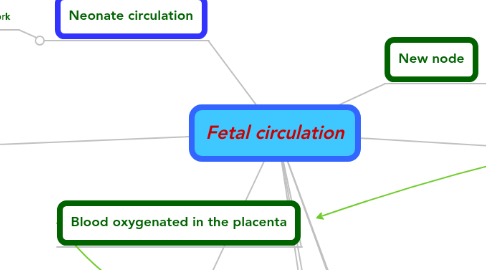
1. 50% to the liver
2. Blood then joins inferior vena cava => to the right atrium
2.1. Most of the blood passes to the left atrium via the foramen ovale
2.1.1. Foramen ovale closes separating right atrium from the left
3. Oxygenated blood taken by umbilical vein to
3.1. Umbilical vessels become ligamentum Teresa
4. 50% to ductus venosus
4.1. Becomes ligamentum venosusum
5. Blood oxygenated in the placenta
6. Neonate circulation
6.1. Baby takes first breath/ placenta ceases to work
6.1.1. Pressure falls in pulmonary venous resistance
6.1.1.1. Blood drawn to lungs
6.1.1.1.1. Blood back to heart via pulmonary veins
7. New node
8. Immature renal function
8.1. Can prevent dehydration and eliminate lower level metabolic waste products of breast feeding infant
8.2. Low glomerular filtration rate
8.3. Half life of drugs are increased as slow elimination by renal system
9. => left atrium to left ventricle
9.1. => ascending aorta- blood circulates the upper half of the body (brain)
9.1.1. Via the superior vena cave => returns to the right atrium
9.1.1.1. This blood passes to the right ventricle
9.1.1.1.1. pulmonary artery where a small amount of bloods goes to the lungs
10. New node
10.1. Adaptation of the fetus for extrauterine life
10.1.1. Respiration- the lungs
10.1.1.1. Fetus
10.1.1.1.1. Lungs are filled with fluid secreted by lungs: this exchanges with amniotic fluid
10.1.1.1.2. Fetal Breathing Movements are observed from the first trimester becoming more regular with gestation
10.1.1.2. Neonate
10.1.1.2.1. Factors that stimulate first breath: temperature change, clamping of the cord ^ventilatory drive, compression of vaginal delivery
10.1.2. Temperature regulation
10.1.2.1. In utero- dependant on mother
10.1.2.2. In the neonate
10.1.2.2.1. Temperature loss after birth due to change in environment
10.1.2.2.2. Mechanisms for losing heat is not well developed
10.1.3. Liver
10.1.3.1. Immature function
10.1.3.1.1. Glucose regulation
10.1.3.1.2. Fuel storage
10.1.3.1.3. Billirubin
10.1.4. Gastrointestinal system
10.1.4.1. Neonate has immature digestive tract and absorptive capacities
10.1.4.1.1. Hormone and enzyme production
10.1.4.2. Feeding reflex= can suckle from birth
10.1.5. Kidneys
10.1.5.1. In utero
10.1.5.1.1. Placenta maintains osmotic pressure
10.1.5.2. In the neonate
10.1.6. Bowel movement
10.1.6.1. Meconuim- mucous, epithelial cells, fatty acids and bile pigments
10.1.6.2. First bowel movement within 24hours.
10.1.6.2.1. Stool slowly combines with metabolic waste and eliminates all meconium
10.1.7. New node
